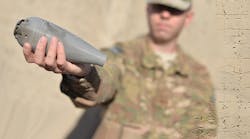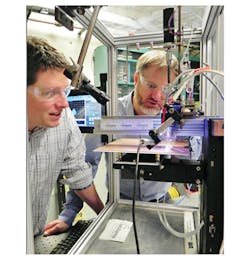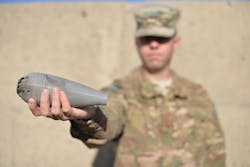There’s one maxim that Hollywood films and real life actually have in common: Explosives are serious business. The idea of arming and disarming them in movies such as the Hurt Locker and The Italian Job can be as intense as real life. The ignition system is incredibly important—if you have an ignition that goes off easily, it might go off when you don’t want it to. However, if the ignition system is more stable, it might not go off when you want it to.
In a paper from the Los Alamos National Laboratory, Alex Mueller is leading a team to create the next-generation of explosives using 3D printing. By examining the microstructure and manipulating internal hollow spaces of TNT, the scientists are trying to control and tailor a new form of explosives.
TNT is susceptible to unplanned detonation. This led the team at Los Alamos to develop insensitive high explosives (IHE). These explosives can be hit with a hammer, dropped, or thrown into a fire and not detonate. This might ruin some Hollywood movies, but it might also ruin a timed detonation.
Hot Spots
Making an explosive more difficult to detonate when there’s an accident also makes it more difficult to detonate intentionally. Explosives such as TNT’s behavior are largely controlled through hot spots. Introducing inclusions, such as air bubbles, into TNT will trap air inside, causing it to compress and rapidly heat up. The uneven flow into and around these bubbles results in points of intense heat called hot spots. These hot spots largely control the energy necessary to initiate detonation in TNT and other high explosives.
Los Alamos chemists Bryce Tappan (left) and Alex Mueller (right) watch as the Hyrel System 30M 3D printer produces a little cone of mock explosive material. The process allows custom tailoring of internal structures that was not previously possible.
This is where 3D printing is disrupting explosives. With the ability to control material, and voids, Mueller’s team looks to control the release of energy through a sophisticated arrangement of hot spots.
“The ability to tailor sensitivity and the resultant energy release in the chemical reaction zone would be a holy grail in detonation physics research,” says Dana Dattelbaum, a Los Alamos detonation expert. “Control and manipulation of structures at the microscopic scales through 3D printing is an exciting step toward achieving these goals.”
3D printing lets the material be manipulated at a mesoscale, which is difficult to do with conventional methods. Printing in mesoscale layers eliminates variables and unpredictable hot-spot areas.
Los Alamos is using fused-deposition modeling and an optically cured method of 3D printing to make explosives safer. However, the real work/excitement isn’t that the team is revolutionizing the process, but that they are working on all new materials. Like many solutions today, the work seems to be in the material science—a trend that is echoed in research over 2,000 miles away.
Trading TNT for Thermite
Researchers at Purdue University have manipulated an inkjet printer for their explosive work. “It is really just an assembly of commercial-off-the-shelf technologies,” says Jeffrey Rhoads, professor of mechanical engineering and principal investigator on the project. “The key is formulating the proper ‘ink’ and then integrating these components in a way that allows for appropriate mixing, precise printed geometries, etc.
“Our solution is to combine two components as we’re printing them. We can have a fuel and an oxidizer in two separate suspensions, which are largely inert. Then with this custom inkjet printer, we can deposit the two in a specific overlapping pattern, combining them on a substrate to form nanothermite.”
In this photo, Allison Murray, a Ph.D. candidate in Mechanical Engineering (left) is holding a film with two 3D-printed explosive “P”s in her hand. According to 3ders.org, Purdue used a nanoaluminum and nanocopper (II) oxide in a dimethylformamide with polyvinylpyrrolidone to create a nanothermite in an overlapping pattern. The result is this 3D-printed “P” being ignited in a controlled explosion.
The modified piezoelectric inkjet printer moves with one-tenth-micron precision by holding the nozzle still and moving the print bed. Working in picoliter volumes means that controlling droplet size is imperative. Deformation of the piezoelectric material is controlled through the voltage applied to it. The piezoelectric material is connected to a tube; by altering the voltage, researchers control the droplet size.
Thermite produces high heat and thrust. Using 3D printing to control it could lead to applications we haven’t discovered yet. For now, it could be used in airbag ignition systems, and many applications in industrial and military defense.
Military-Grade Explosives
Both Los Alamos National Labs and Purdue are looking at precise control of small explosives. Perhaps these could be scaled up to please the movie-going public, but fortunately, 3D printing is just starting to “blow up.” Along those lines, while not as precise or as small as what researchers are developing, the U.S. Marine Corps has successfully tested 3D-printed explosives.
3D printing has also helped with training for the Explosive Ordnance Disposal Marines. Shown is a bomb that could be a threat to public safety. However, shooting a steel slug through the fuse will render it a paperweight. These bombs originally cost $100 each. Now, though, the military can train more extensively because 3D-printing them costs a mere $5.
For this research, the military didn’t 3D-print the TNT or thermite, but rather the containers that holds the explosive charge. A team of Explosive Ordnance Disposal Marines tested the 3D-printed containers in early October 2017. The test was successful.
“Once everybody is comfortable with the material and knows how to utilize it, it opens up the possibility of being able to design something and print it on the spot, something that you can’t buy and doesn’t even exist,” says Staff Sergeant Jared Green.
Having a 3D printer on base or on a vehicle could allow soldiers to 3D-print parts within a day. This could eliminate logistics and shipping time for replacement parts. In addition, it can do away with having to carry around spare parts that may never be needed. According to 3DPrint.com, “There are several 3D printers being actively used in combat zones in the Middle East, and the benefits of having an on-demand mini factory in the field are numerous.”
Going Nuclear
Another military operation was carried out in Pantex Plant, a federal nuclear weapons facility in Amarillo, Texas. Security is important when handling explosives. And if the importance of safety increases with the size of explosion, nuclear weapons have no room for error.
Tek Ferguson, an applied technology specialist at Pantex Plant, wrote an article in 2016 stating, “In order to maintain the U.S. nuclear deterrent at a level appropriate for the 21st century, technicians in the Pantex Additive Manufacturing Program have spent the past five years evaluating and implementing dozens of applications for additive manufacturing.
“The team works with a Connex 500 for polymer-based designs and uses an SML 280 for metals. Components that once took weeks or even months to machine can now be made in mere days. The fruit of the team’s labor is evident across the 16,000-acre facility in the hundreds of fixtures now being used. In 2014, the Additive Manufacturing team received an esteemed Defense Programs Award of Excellence for its work.”
Many industries are finding indirect uses for 3D printing. Printing fixtures, jigs, and gauges can save work hours, money, and improve ergonomics. For example, making custom fixtures cost the Pantex Plant about $30. The process was expensive, time-consuming, and inadequate. With 3D printing, the fixture was printed in a single-piece fixture that is also reusable. The new design saved more than $300,000 in work hours every year.
In addition, the ability to print complex shapes lets users take advantage of topographical optimization, meaning material is only added where needed. This would be expensive, time-consuming, and in some cases, impossible with traditional processes. In a life extension program for the B61-12, which is a nuclear weapon, topographical optimization is able to make a new fixture that saves cost, weight, and time, while increasing strength.
3D printing is disrupting many industries, and the explosives market represents just another example. More interesting is finding new, creative ways to use this technology with alternative materials. Basic applications are simply expanding powdered metallurgy, or finding better shapes or uses for plastics. However, 3D printing of explosives shows how using multiple materials mixed together in powder, liquid, or suspended in a liquid is changing the direction in which researchers approach problems. As researchers become comfortable with 3D printing, we will see more materials enter the mix, and new ways of viewing and solving problems.




